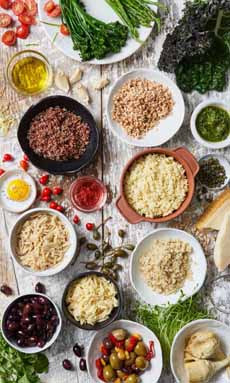TIP OF THE DAY: Make A Grain Bowl
|
If you order grain bowls at cafes or take-outs, have you ever made them at home? A grain bowl is essentially a complete meal in one bowl. Combining whole grains, proteins, vegetables, and dressing, it’s a nutritious and filling lunch or light dinner, This tip from DeLallo Foods is an easy blueprint. There’s no exact science. 1. WHOLE GRAIN. There are many grains to choose from. Working through the list, you can change the personality of your bowl time after time. Some favorites: barley, brown rice, couscous, farro, freekeh, kamut, millet, polenta, quinoa, spelt berries. You can also use smaller pasta shapes like orzo and acini di pepe, but you may not be able to find them in whole grain. Mini Tip: Cook your grains in vegetable or chicken broth, instead of water. (Check out all these grains in our Beans & Grains Glossary.) 2. PROTEIN. Make it light or hearty with beans, chicken, a fried or poached egg, pork, shrimp, tofu, tuna. Leftover proteins are more than welcome. 3. VEGETABLES. Fill up on a boatload of greens and other vegetables, raw, roasted or otherwise cooked. Try arugula, bell peppers, broccoli, carrots (we like carrot curls), chard, mushrooms, spinach, and anything that appeals to you as you peruse the produce aisle. Assemble varied colors: orange sliced sweet potatoes, purple cabbage, red bell peppers, red or orange beets, red radicchio. You can also add pickled and marinated vegetables, from dilly beans and pickled jalapeños marinated artichoke hearts. Steamed baby potatoes are fun. 4. DRESSING. You can use a salad dressing or a sauce like peanut or pesto. We prefer to keep it simple with a drizzle of balsamic vinegar and extra virgin oil, perhaps a squeeze of lemon or lime juice. But you may prefer honey mustard, Italian or ranch dressing. Go for it. 5. GARNISHES. Garnishing is an opportunity to add more favorite flavors: avocado, capers, cherry or grape tomatoes, chopped scallions, edamame, fresh herbs, lemon zest, olives, watermelon radishes, etc. We like to add crunch: nuts and/or seeds, trendy roasted chickpeas. |
|
|
|
Set out a grain bowl buffet for your next get-together. Everyone will have fun putting the ingredients together. It’s an opportunity to introduce guests to grains they haven’t had before. At this point, everyone knows what brown rice and quinoa taste like. So pick three or four others from the WHOLE GRAIN list above. And for the mix-ins: The sky’s the limit. A grain bowl is another term for a macrobiotic dish* variously known as Buddha bowl, dragon bowl, grain bowl, hippie bowl, macro bowl or power bowl. These “bowls” began to emerge in macrobiotics around 2014, but the foods they include have been part of a diet philosophy for centuries [source]. Macrobiotics is both a practice (a diet) and a philosophy (way of life). The belief, drawn from Zen Buddhism, is that its balanced diet (the balance of yin and yang) is the basis of good health, which delivers true happiness and freedom. The macrobiotic diet is based on whole grains, vegetables, and beans are the mainstays of the diet; it mostly limits animal fat (fish is the one exception). Here’s an overview of the diet, including what is and is not recommended. The diet may be beneficial for people dealing with heart disease and high cholesterol. While the American Cancer Society stops short of recommending macrobiotic diets to prevent cancer because there’s no scientific evidence, it does say that researchers believe eating a plant-based, low-fat, high-fiber diet lowers the risk of heart disease and some kinds of cancer [source]. It depends on what the eater desires to eat, in the categories of beans/legumes, grains and vegetables. Think of a large bowl layered with beans, brown rice or other whole grain, seasonal vegetables, sea vegetables (e.g. seaweed), tofu or fish for protein, and a garnish of fermented or pickled vegetables. If you’d rather garnish your grain bowl with avocado, carrot curls, chopped scallions or jalapeños, go for it! ________________ *While modern eaters may add eggs, fish or other animal-based protein to the bowl, a traditional macrobiotic diet allows only fish.
|
||




